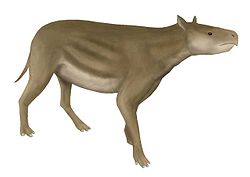| Mesatirhinus Temporal range: Eocene, | |
|---|---|
 | |
| Mandible of M. megarhinus | |
| Scientific classification | |
| Kingdom: | Animalia |
| Phylum: | Chordata |
| Class: | Mammalia |
| Order: | Perissodactyla |
| Family: | † Brontotheriidae |
| Genus: | † Mesatirhinus Osborn, 1908 |
| Type species | |
| Mesatirhinus megarhinus Earle, 1891 | |
| Species | |
| |
Mesatirhinus is a genus of brontothere endemic to North America during the Eocene living from 50.3 to 42 mya, existing for approximately 8.3 million years. [1]










